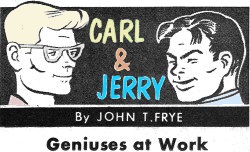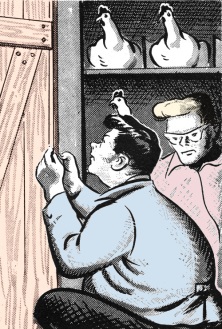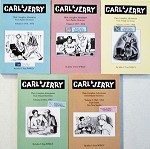Carl & Jerry: Geniuses at Work
|
|||||||
In typical Carl & Jerry style, the teen experimenters ("makers" or "DIYers" in contemporary lingo) spent another summer vacation day cobbling together an electromechanical contraption or even purely electronic device with a specific goal in mind. Whether designing and building a circuit for tracking down the cause of strangely acting synchronized wall clocks ("The Crazy Clock Caper") or devising a system for catching a vandal in the act of vandalizing ("Geniuses at Work" - this story), creator John T. Fry provides a mix of developing personalities, describing the task at hand, and maintaining a degree of suspense regarding how the adventure will end. Carl & Jerry: Geniuses at Work By John T. Frye
"So, okay; I give up. What are you doing with that timer clock, making a time bomb? "Not at all," Carl answered, taking off his horn-rimmed glasses and wiping them with a very dubious-looking handkerchief. "You know what a large charge I get out of these bright, warm, sunny, sparkling summer mornings. I don't want to miss a single one of them, and this timer clock I built from that article in the May, 1955, issue of Popular Electronics will make sure that I won't. A 110-volt a. c. electric gong that used to be in a fire station is plugged into the 'turn on' outlet on the back of the timer and converts it into an electric alarm clock that nobody, but nobody, can ignore." "At the same time," Carl continued, "you know that my second love is sleeping, and nothing gripes me quite so much as to have that gong bounce me out of bed only to discover it's a cloudy or rainy morning good only for staying in the sack. What I'm doing now is taking out insurance against such a revolting development. This sun-battery photocell will be mounted outside my window where the rays of the rising sun can shine directly on it. Leads will go from the cell to a sensitive relay whose contacts close only when direct sunlight falls on the cell. These contacts are inserted in one of the leads going to the gong, and -" "I get it," Jerry broke in, admiringly. "If it's a cloudy day, the relay contacts will stay open and keep the timer from ringing the gong; but if the sun is shining, then the timer clock will wake you - and doubtless the rest of the household - at the time for which it is set. My boy, you're a real brain!" "Really nothing," Carl said, with airy modesty. "What are you doing there?" "Well," Jerry said hesitantly, "I guess you might say I was making a mug-trap." "You're not getting through to me. Try another wavelength." "It's this way," Jerry explained. "My Uncle Walter, who lives on a farm just south of town, has something very funny going on in his henhouse. About every other night, something or somebody - probably the latter - goes into the henhouse, tears up the hens' nests, and scatters them all over the floor." "Why do you say it's probably 'somebody'?" "Because my uncle thinks that only a human being would be able to unfasten the rather complicated latch on the door. He says, too, that if it were a fox or a skunk or a weasel, such an animal would kill the chickens and eat them; but all the mysterious visitor does is scare heck out of the hens. They're so nervous that their egg-laying is falling off."
"Uncle Walt, who realizes I'm an electronic genius, wants me to help him catch the critter, or at least to find out what it is. He doesn't want to use any ordinary kind of trap because he suspects that may be kids are doing the mischief, and naturally he wouldn't want to hurt them. At the same time, he doesn't want just to sit around and have his prize hens scared silly." "What've you got in mind?" "I can show you a lot easier than tell you. Why don't you go out to Uncle Walt's with me and stay all night? You can tell your mom I invited you." "It's a deal! Wait until I get my leg-power hot rod, and I'll be right with you. I've got to see this Strange Case of the Harassed Hens to a finish." Carl's mother had no objection, and soon the boys were riding their bikes toward the farm. As was always the case when something interesting was in prospect, they didn't use the seats of the bicycles much, and they soon arrived at the prosperous-looking farm of Jerry's uncle. Uncle Walt was a tall lean man with bright blue eyes set deep in a lined and weathered face. After Jerry had introduced Carl and explained that he was going to stay all night, the man turned to his nephew and said, "Well, how about it, Marconi? Are you all set to give our mysterious visitor his comeuppance?" "I think so, Uncle Walt. If you don't mind, Carl and I will get busy right away setting up the - the - the device." "Be my guests, boys!" Uncle Walt said with a grin, waving toward the neat, well-painted chicken house. "I'll go and start the milking." "First," Jerry said, as he started unloading the cardboard box he had brought along, "we'll mount this normally closed micros witch on the door jamb so that its contacts are held open by the closed door, and so that the contacts will close just as soon as the door starts to open. As you can see, the switch is inserted in one wire of this line cord, which will go from an outlet socket inside the chicken stable to the rotary solenoid fastened to this board with the camera." "Hold it! What exactly is a rotary solenoid?" "It's a solenoid that twists a shaft through an arc of several degrees when current is applied to it, instead of moving a plunger as the ordinary solenoid does. The little arm fastened to the rotating shaft connects through this small spring to the shutter release of the camera. And notice that at the end of the little arm's travel it flips this toggle switch from on to off" "Two questions: why use the spring, and what does the toggle switch do?" "First," Jerry said, "we'll mount this normally dosed micro switch on the door jamb so that its contacts are held open by the dosed door ..." "The first thought of any experimenter or technician worth his salt is to protect his equipment against possible damage, and that's the function of both the spring and the switch. This rotary solenoid is very fast-acting, and I was afraid it might injure the camera unless a shock-absorbing linkage was used between the arm and the shutter release. Also, this solenoid is intended only for intermittent use and would overheat and be destroyed if current were allowed to remain on it for a long period of time, as would happen if the door of the chicken house were left ajar. The switch is in series with the micro switch and takes the voltage off the solenoid after it has done its job of tripping the camera. What's more, with this switch in the off position, the door can be opened without tripping the camera - an important factor in setting things up, testing, or using the door during daylight hours when we don't need to have the trap set." "Where will the camera be placed?" "Back inside this box to protect it from the weather. The lens will be focused on the door, and when the solenoid trips the shutter, the synchronized flash will light up the whole area, providing us with a fine 'mug-shot' of whoever or whatever is fooling with the door." Carl walked slowly around, studying the layout from all angles. "I see only one thing wrong," he finally remarked. "If the prowler is human, the firing of the flash bulb is bound to show him where the camera is. What's to prevent his taking camera, evidence, and all along with him?" "That's using the old hat-rack!" Jerry applauded. "Since it's my camera, that worried me, too. But I've got the solution right here." As he said this, he reached down into the cardboard carton and pulled out an electric bell. "This bell will be connected across the line cord going to the solenoid. It'll be behind the micro switch but ahead of the toggle switch. That way it'll start to ring as soon as the door is opened, and will keep on ringing until the door is closed or until we come out and shut it off. Beast or human, it would have to be an iron-nerved character to stick around with this bell clanging away." With the plan clearly in mind, the boys set to work and completed the installation in short order. They put the box housing the camera at one side of the door where it would be most likely to get a good profile shot of anyone looking down at the latch. When everything was in place, Jerry flipped the toggle switch on the camera mounting board to off and plugged the line cord into a receptacle inside the building. Instantly the electric bell began to ring loudly; but it stopped when the door was closed. Jerry thrust a bulb into the flash gun mounted on the camera and called to his uncle who was just going to the house with a brimming bucket of milk dangling from each arm: "Uncle Walt, will you want to go into the chicken house any more during the evening?" "Nope, I'm all through in there; so you can set your trap. Then you boys come on up to the house and wash up for supper. It ought to be about ready -" After one more final inspection of the wiring, Jerry flipped the toggle switch to on and the boys followed Mr. Bishop to the house. There, Mrs. Bishop, who looked a lot more like a club woman than a "typical" farm wife, served a fine country meal consisting of golden-brown store-dressed fried chicken, ready-mixed light biscuits covered with plenty of good yellow margarine, and a dessert of commercially quick-frozen strawberries spread over large mounds of luscious vanilla ice cream from the local ice cream plant. This huge meal and the outdoor exercise the boys had had made them so sleepy that they were barely able to stay awake until nine o'clock. Right after that, they all went to bed. It seemed to Jerry that his head had barely touched the pillow before he found himself sitting bolt-upright in bed, staring into the darkness, while the distant ringing of a bell came through the open window. Nimbly he hopped out on the floor and switched on the light, only to discover that Carl was already tugging his pants on over his pajamas. "Sounds like we got a rat in our trap," Carl grunted, as he tried to wriggle a bare foot into his shoe. The boys pounded down the stairs and out into the barnyard. The bobbing circle of light from Mr. Bishop's flashlight guided them to the hen house where Uncle Walt, a double-barreled shotgun cradled in the crook of his arm, stood looking at the open door of the building. "Whatever the thing was, it took off when the bell started to ring," he told the wide-eyed youths; "but if your contraption worked, you should have his calling card inside the camera." An examination with the aid of the flashlight revealed that the toggle switch had been flipped to off, indicating that the camera shutter had been tripped. Jerry removed the camera from the board and advanced the film to the next exposure. "It's only two a. m.; so we may as well go back to bed," Uncle Walter suggested, as he closed and latched the door. "I'll see you young buckeroos at breakfast." For a few minutes after getting back in bed, Carl and Jerry were too excited to go to sleep. But they soon calmed down and drifted off into slumber. They knew nothing more until Jerry's Aunt Enid knocked at their door and told them that breakfast was ready. The boys bolted their breakfast pancakes and sausage in short order. They paused only long enough to take a couple of pictures of Mr. and Mrs. Bishop, "just to finish off the roll" as they unflatteringly put it, before they hopped on their bicycles and headed back for town and the darkroom Carl had fixed up in a corner of his basement. Inside this room, with the safelight turned on, Jerry removed the roll of Verichrome film from the camera, stripped off the backing paper, and attached clips to the ends while Carl filled one tray with developing solution, another with clear water, and a third with hypo. A quick check with a thermometer showed that by one of those happy coincidences that do happen occasionally, the solutions were exactly at 68 degrees. Carl passed the strip of film through the clear water a couple of times and then began to seesaw it gently and methodically through the tray of developing solution. After a couple of minutes, Jerry, whose head had been bobbing up and down with the movement of the film as he tried to make out the emerging negative pictures, muttered: "We didn't draw a blank, anyway; there's something on every frame." "By golly, it's a midget burglar!" Jerry declared, looking over at the negative which was third from one end of the strip of film Carl had developed. After a couple more minutes of passing the film through the developer, Carl transferred it to the clear water for a few passes and then began to seesaw it through the tray of hypo. When he had done this for several minutes, he stopped and turned on the white light. "By golly, it's a midget burglar!" Jerry declared, looking over at the negative which was third from one end of the strip of film Carl had developed. "Burglar, my eye!" Carl said with a grin. "That's a coon, and a big fat one at that. All coons have that distinctive mask-marking around the eyes. There's something around his neck I can't make out on the negative. Let me finish fixing, washing, and drying the film. Then we'll make a print so that we can really see the details." An hour later both boys were examining a fine large print of the raccoon, which must have been staring directly at the camera when the flash bulb went off. It was standing on its hind legs, and its little paws still had hold of the latch. Around its neck was a leather collar with a metal plate fastened to it. "That must be a pet coon," Jerry said. "I'll run upstairs and tell Uncle Walter, and see what he knows about it." In a few minutes, he came back into the darkroom with a broad grin on his face. "The mystery is solved. Uncle Walt says that the coon is a pet of a boy who lives on the next farm. It's so tame that they just let it run loose like a dog. It must have been prowling around Uncle Walt's farm when it discovered how to open the chicken house door - coons are very clever about things like that - and then had itself a real ball scaring the hens. This was so much fun, evidently, that the coon came back and did it again every night or so. Uncle Walt called the boy, and he promised to keep Mr. Coon tied up at night. "Another victory for the electronic coon hunters!" Carl remarked, starting to put away the developing materials.
Posted February 22, 2023
|
|||||||

 For an hour Carl and Jerry had been working
away on separate projects at opposite ends of the workbench in their basement laboratory.
Each was too stubborn to ask what the other was doing, but the puzzled glances each
of them sneaked at the other's equipment from time to time revealed how great was
the strain. Finally Jerry cracked.
For an hour Carl and Jerry had been working
away on separate projects at opposite ends of the workbench in their basement laboratory.
Each was too stubborn to ask what the other was doing, but the puzzled glances each
of them sneaked at the other's equipment from time to time revealed how great was
the strain. Finally Jerry cracked. 
 Carl & Jerry, by John T. Frye
Carl & Jerry, by John T. Frye